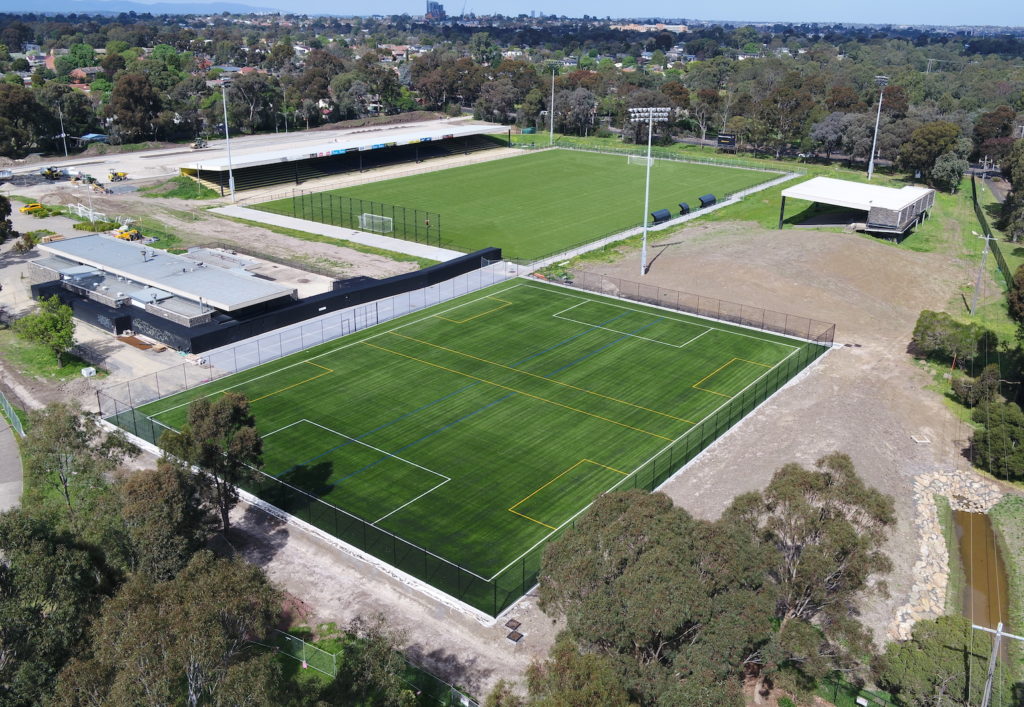It’s easy to look at a new sporting facility and focus on the building and stadium design, overlooking the main attraction and reason for the facilities are the quality of the playing fields themselves.
Specialist field of play engineering firm SPORTENG is working with planners, architects and developers to help them understand the design elements so that the fields themselves are the real winners, whether for a community facility, university precinct or a large stadium.
Noticing a gap in the market six years ago, SPORTENG began with a vision to bring the professionalism and quality of a large engineering firm engagement to the field of play sector. As an agile independent firm focusing on high quality and technical expertise, the strategy has worked well for SPORTENG. It has already notched up more than 700 sports projects since they began.
The firm has worked with clients as diverse as the Sydney Olympic Park Authority, University of Sydney, Gold Coast 2018 Commonwealth Games Corporation, Tennis Australia, West Coast Eagles Football Club and City of Casey Council, to name a few. It is helping to design the field of play for the redeveloped Sydney Football Stadium, which was demolished in 2019 to make way for new facilities.

“There are a lot of areas where developing fields of play can go astray,” said Jarrod Hill, CEO and Director of SPORTENG.
“We often see a lack of understanding in the industry around how to design them. We also see local government or community sporting clubs take on projects that seem straightforward but turn out to be quite complex once they step further into it. That can lead to costly mistakes and fixes down the road, and often there are no band-aid fixes for fields of play.”
People sometimes see the SPORTENG team as design consultants, Hill said, and bring the firm on board once they have the funding sorted.
“However, we can help much earlier than that and identify likely issues ahead of time and plan for risk before the funding stage,” he said.
“Aside from larger clients, we also work regularly with councils and other smaller organisations to help them achieve a high-quality outcome at the right scale for their projects.
“I get just as much of a kick out of opening up a community facility as I do a big stadium project. My very first project was the John Landy Athletics Field in Geelong. I recently visited the facility, and it’s awesome to see how the community are still using it to this day.”
When it comes to natural turf fields of play, agronomic aspects need to be considered as well as the supporting engineering elements. Engineers typically want layers within a pavement profile well compacted free of voids. However, natural turf fields of play experts require a profile that does not readily compact. This enables voids to be present within the profile to be present, supporting healthy root growth by providing sufficient space for water and air to pass through.
In synthetic fields of play, a more traditional engineering pavement approach can be adopted. However, it is crucial to understand how the overlying synthetic system needs to interface with the underlying engineered base and associated infrastructure.
“The first step with any site is to ensure there has been an extensive site investigation on the grounds,” Hill said.
“Most public spaces are constructed on pretty ordinary locations, and there’s often a reason why there are no buildings on the sites already. Sites could be former contamination sites, be located in a flood-prone area or have other aspects that prevented building structures or facilities there in the past. A thorough site investigation consisting of a level and feature survey, geotechnical investigation and contamination testing ensures the team is aware of all the aspects to put forward the right solution.”
Getting sporting facilities right can have longer-term advantages for clients as well. The SPORTENG team delivered a significant upgrade to Deakin University with their Elite Sports Precinct in 2017. The SPORTENG team helped to go beyond the brief and show the client that by extending the AFL oval length to meet professional requirements, the Geelong Football Club could also use it as a training venue.
The facilities at Deakin also includes a cricket pitch, an approved World Athletics running track, a FIFA-endorsed synthetic grass soccer pitch, an incline sprint track and long jump facility, synthetic grass baseball diamond and an outdoor workout equipment. Deakin University ranks third in the world for sport and exercise science, and its world-class facilities for elite athletes are a drawcard for students.
Take a look at SPORTENG’s extensive work portfolio and get in touch with the team for their Field of Play expertise at www.sporteng.com.au.

